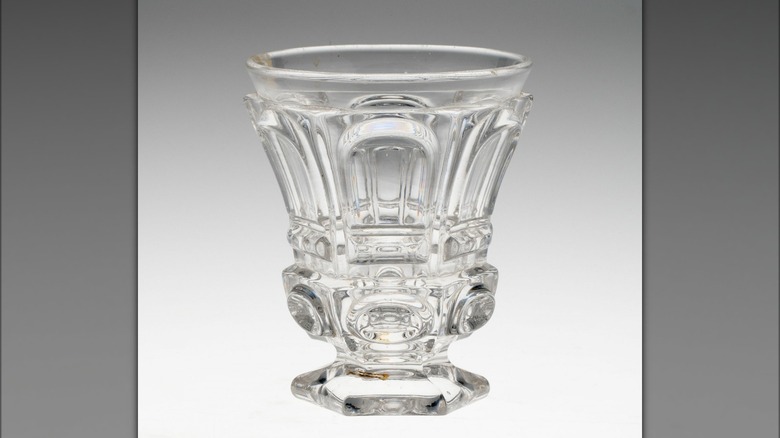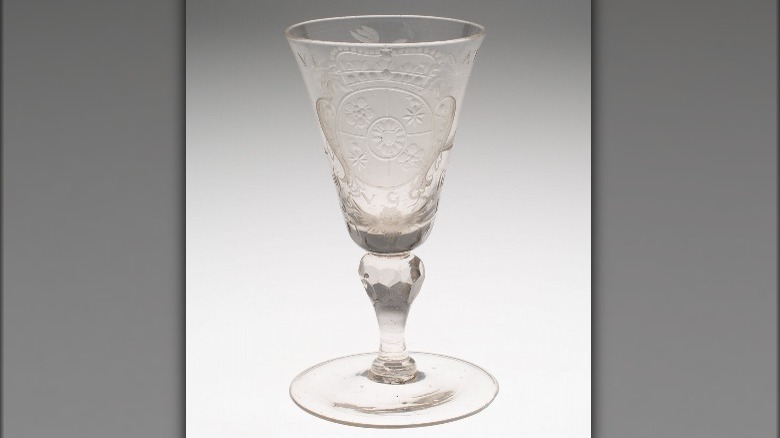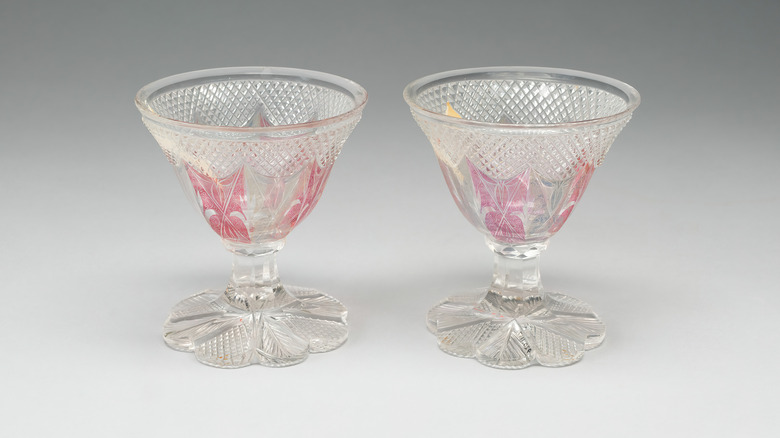Is It Safe To Drink From Lead Crystal?
Any time there's something to celebrate, we clink glasses. It's one of the most fun parts about announcing good news. The keyword, though, is "fun." Announcing "cheers" with a wine glass or a champagne flute is enjoyable and amusing, but crystal takes things up a notch. Clinking crystal glasses is regal. It's an event. But there's also a downside to this elegant drinkware.
For the most part, people probably only think about their glassware in terms of how different wine glass shapes affect their drink — pro tip: champagne flutes aren't a good choice — but they really should think more about their crystal. For a glass to be crystal, it is infused with lead, which adds weight, clearness, and cleavage, via Dusty Old Thing. According to the antique aficionados, the process was invented in England during the seventeenth century. Lead, it says, is the active ingredient in creating the elaborate fractal patterns that come to mind when you think of a crystal goblet. Infusing lead into crystal also makes the glass much tougher for blowers to manipulate. Because of this lead crystal glasses are some of the most expensive drinkware, and often become intergenerational heirlooms.
But, the lead content of this type of crystal has been the cause for concern for many crystal fans. Is it something to worry about? Or is it no big deal? The answer to both questions is a resounding: "kind of."
What is lead crystal glass?
Before regulation in 1969, most crystal glass contained around 36% lead, per Dusty Old Thing; since then, glassblowers have generally considered 24% lead standard. Today, according to Gurasu Fine Crystal, any glass that contains between 10% and 24% should be labeled as crystal glass.
The greater the lead content, the greater the sparkle and brilliance of the glass (via Artistry in Glass). However, despite the beauty it imparts to glassware, lead also poses the threat of contaminating our food supply if exposed in great enough amounts, per the U.S. Department of Agriculture. According to the Environmental Protection Agency, lead is a naturally occurring but toxic element released by fossil fuels, gasoline, and other human activities. The Food and Drug Administration, reports that lead, like other heavy metals, does not biodegrade or disappear from the environment over time, so the lead content in those heirloom crystal glasses sticks around. The lead that was in your grandma's fine crystal is still there when it becomes yours. But does it pose a risk?
The risks of lead poisoning
The Government of Canada explains that lead crystalware can release lead into the food and beverages it comes in contact with. Any exterior decorative pattern around the rim, such as a coating or glaze, it warns, can also release lead.
Lead poisoning is very common. According to Mott Children's Hospital, 1 in 40 children between 1 and 5 years old have an unsafe amount of measurable lead in their bloodstreams. Luckily, most fans of crystal glass are likely well over the legal drinking age, but adults are not immune to the risk. Lead poisoning primarily impacts the brain and nervous system, via the Mayo Clinic. High levels of lead exposure, it says, can lead to serious neurological consequences, including learning disabilities and behavioral difficulties in children; even low-level exposure can pose serious health hazards over time.
In order to safely use those impressive lead crystal glasses, the most important thing is moderation and minimizing the length of exposure. The Seattle Times cautions against using those ornate crystal decanters to store wine, brandy, or any other liquor long-term. Instead, save the crystal for sipping at the table. If you're still feeling wary of those glistening glasses, you can always grab a lead test kit. The EPA recommends the brands 3M LeadCheck and the D-Lead. The best accouterment to a glass of wine is peace of mind.


